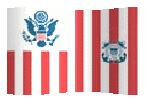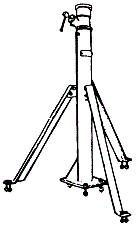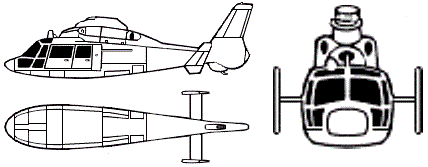


 |  | ||||
|---|---|---|---|---|---|
Centuries ago, the Terran Eurocopter corporation developed the SA 365/AS365 Dauphin 2 as a medium general-purpose, twin-engine helicopter for search & rescue (SAR),
An armed version was introduced a few years ago, similar to the now obsolete (without blueprint) MH-68 Stingray helicopter. The armed version is identical to the unarmed one, making conversion from unarmed to armed as simple as finding or transferring guns, and are armed with either an M-2 .50 Caliber Machinegun or M-550d PBC and a pair of EP-37 60MM EP-40 40MM or PB-22a PBC. These are usually used both to disable a boat (shooting the engines, forcing them the heavy to) and insert a boarding crew (since the boat did run, it's reasonable to think they might not allow themselves to be boarded). More recently, though, the UGC has approved a fleet wide upgrade to add the L-02 rail launcher for this purpose. The gun is fixed-forward and is "supposed to be" used only for disabling fire, using a Type 92 slug (just a polycarbonate with ferromagnetic [metal] shavings embedded), but as more than one smuggler has discovered, "If you get in the way, you get in the way." NOTE: Because the craft does not have rotors, it can not auto rotate for a crash landing. Name: Dolphin Helicopter Model Type: Utility/SAR Helicopter Crew: 4; Pilot, Co-pilot, Crew Chief, and Flight Crewman. Passengers: Up to 5 passengers can be carried if necessary. MDC By Location: | |||||
| Fuselage- Cockpit- Air Intakes (2)- Thruster Nozzles (2)- Grav Pod- | 200 150 100 each 100 each 150 | Pilots Doors (2)- Passengers Doors (2)- Weapons Pylons (2)- Tail Boom- Tail Rudder- | 150 each 150 each 100 each 150 150 | ||
| Speed and Statistical Data: | |||||
| In the air: 165 knots Range in the air: 1,000 miles On the water: Drift (minimal direction control). Range on the water: Wherever the currents take it. Minimal control is possible. On the ground: 10 MPH Range on the ground: 5 miles. Length: 44 feet, 5 inches Width: 9 feet 2 inches. | Height: 13 feet. Cargo: Pilot and crews emergence supplies and about 2.5 tons can be carried. Power System: Twin LRS-750B Hydro-cell Jet Engines. Flight Systems: Grav Pods and Hydro-Cell Jets. Cost and Availability: 20,000credit new and unarmed; Every 3 months another batch of 10 becomes available. Black Market Cost and Availability: An equivalent system would cost between 2,000 and 25,000credit, depending on buyer and seller; Not very common at all. | ||||
| Weapons Systems: | |||||
| 1. TM-5 Plasma Launcher: A basic, ball-turret mounted plasma launcher. The weapon itself is based on the T'sentraedi plasma launcher, but has FAR superior range (due to a greater number or primer rings). The weapon is mounted on the nose. Purpose: Defense/Anti-Infantry/Power Armor MD: 5D6 Rate of Fire: Standard; Pilot or copilot can automatically use this weapon. Range: 6,000 feet Payload: Unlimited  2. Door Gunners: Each side of the helicopter has a heavy weapons mounting pintle; Any type can be used, though heavy energy weapons or the RG-41 rotary gun are preferred for these positions. Generally used for anti-power armor work. An E-cable provides unlimited capacity to energy weapons. Most such guns are on butterfly grips, though some remain on standard grips with shoulder stocks (to improve accuracy). Standard versions consist of the M-6 pedestal mount, though a 3-point sling mount for medium machineguns and similar weapons is also available, which "can" (has) but should not be used to lean outside the helicopter to the point the gunner can actually fire UNDER the helicopter. For projectile-based weapons, around 1,000-5,000 rounds are typically carried (depending on size). (Depicted is an M-31c, which differs in that is has three legs.) 2. Door Gunners: Each side of the helicopter has a heavy weapons mounting pintle; Any type can be used, though heavy energy weapons or the RG-41 rotary gun are preferred for these positions. Generally used for anti-power armor work. An E-cable provides unlimited capacity to energy weapons. Most such guns are on butterfly grips, though some remain on standard grips with shoulder stocks (to improve accuracy). Standard versions consist of the M-6 pedestal mount, though a 3-point sling mount for medium machineguns and similar weapons is also available, which "can" (has) but should not be used to lean outside the helicopter to the point the gunner can actually fire UNDER the helicopter. For projectile-based weapons, around 1,000-5,000 rounds are typically carried (depending on size). (Depicted is an M-31c, which differs in that is has three legs.)3. L-02a Rail Launcher: Part of the 2481 Upgrade program, the LIMA-02 (said "LEE-MA zero too") is fed from a 100-round magazine. The system is radar controlled and designed for Micro-Missiles. Purpose: Anti-smuggling (disabling fire). Damage and Range: Varies by type used. Rate Of Fire: Per gunner's attacks per melee. Payload: 100 micro-missiles. Bonus: No bonus on this platform. | 4. Wing Pylon Mounted weapons: The Dolphin can carry up to 2 weapons on its 2 wing pylons. | ||||
| A) TM-12 Fuel Pod: Essentially a modified version of the M-11 Torpedo Pod. In this case, however, it is used as a fuel pod to double the normal range of the craft. B) Type M-7 Rocket Launcher: 24 2-inch rocket tubes in 12 rows of 4 each. Each rocket tube has 4 rockets. Purpose: Heavy Assault MD: Each rocket does 2D6 MD Rate of Fire: Volleys of 6 or 12 times pilots attacks per melee. Range: 12,000 feet Payload: 96 per pod. Up to 6 pods can be carried. C) M-11 Torpedo Pod: An ASW torpedo pod. Carries the Mk-82 Airborne Torpedo, essentially a modified version of the Mk-81 Submarine Launched Torpedo. The initial launch is by a nothing so complicated as releasing it from the latches that hold it to the pylon. The on board hydro-cell motor then takes over as soon as the torpedo splashes. Each pod hold 3 Mk-82's. Purpose: Offensive/Anti-Ship MD: 4D6 times 10 per torpedo Blast Radius: 40 feet Maximum Range: 80 miles Minimum Range: 5 miles Rate of Fire: 1 torpedo per pilots attacks per melee. Payload: Each pod holds 3 Mk-82's. | D) External MRM launchers (4): Mainly for shooting down hostile aircraft, though are excellent for shooting down MRM's and LRM's. Primary Purpose: Anti-Aircraft Secondary Purpose: Anti-LRM. Damage: Varies by type used. Rate Of Fire: Volleys of 1, 2, 3, or 4 per pilots attacks per melee. Effective Range: Varies by type used. Payload: 32 (4 per launcher, 6 pods per wing). E) A-11/a Anti-Radiation Pod: A radar and other detection system jammer. Effect: While active, enemy radar will have a "wash" effect, where a large, highly unstable cloud of radar paint will appear. An experienced (5ᵗʰ level and above) radar operator can SOMETIMES use the flow of the wash to narrow down the source of the jamming, but typically this does little good. NOTE: This IS a form of radar signal, and can therefore by tracked by some ESM systems (-10%). F) A-11/v Radiation Detector Pod: This pod passively detects various types of Radiation, most importantly radio signals (for eavesdropping). G) C-441 Canister Pod: Basically a hollowed out version of the M-7 pod, used to drop highly sensitive and extensive messages. A nose-mounted device using GPS or laser detection guides the pod to within ⅛ of an inch of the intended target. | ||||
 | |||||
M-11 Torpedo Pod, and A-11/a Anti-Rad/A-11/v Rad Detector Pods). | |||||
| Features: | |||||
Effect: 01-50 Enemy missile or missile volley detonates in chaff cloud- Missiles are all destroyed. 51-75 Enemy missile or missile volley loses track of real target and veers away in wrong direction (may lock onto another target). 76-00 No effect, missile is still on target. Also note that the chaff cloud will also blind nearby heat sensors (and optically based sensors at night) for 1 melee. They will suffer the following penalties: Reduce melee attacks/actions, and combat bonuses by half. Duration: 1D4 melee rounds. Payload: 60 chaff/flares. Each time the system is engaged, the system fires off 04 chaff/flares. | |||||



